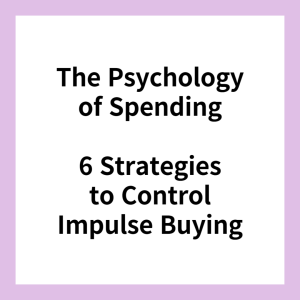The Psychology of Spending: Strategies to Control Impulse Buying

## Introduction
In the world of personal finance, understanding the psychology of spending is crucial to achieving financial goals.
One common stumbling block that many people face is impulse buying.
We’ve all been there – walking into a store with the intention of buying one item, only to leave with a handful of things we didn’t plan on purchasing.
But why does this happen? And more importantly, how can we control it?
In this blog post, we’ll dive deep into the realm of behavioral finance to uncover the root causes of impulse buying.
We’ll discuss the emotional triggers that lead us to make impulsive purchases and explore strategies you can implement to regain control over your spending habits.
## The Brain and Instant Gratification
To understand why impulse buying occurs, we must first examine the human brain’s innate desire for instant gratification.
When we see something desirable, our brain releases dopamine, a neurotransmitter associated with pleasure and reward.
This surge of dopamine creates a pleasurable sensation, which fuels our desire to acquire the item immediately.
Unfortunately, this desire for instant gratification often trumps our long-term financial goals.
Retailers are well aware of this, and they strategically use marketing techniques to exploit our natural inclinations.
From flashy window displays to limited-time offers, they create a sense of urgency that bypasses our rational thinking.
## Emotional Triggers and Impulse Buying
Impulse buying is not solely driven by the desire for instant gratification;
it is also influenced by our emotions. Many of us turn to shopping as a coping mechanism to deal with stress, boredom, or feelings of emptiness.
This emotional connection to spending can lead to problematic behavior and can even become addictive.
Furthermore, societal pressures play a significant role in impulse buying.
In our hyperconnected world, we are bombarded with images of people living seemingly perfect lives.
This constant comparison leads to a fear of missing out (FOMO), causing us to buy things we don’t truly need to keep up with the Joneses.

## Strategies to Control Impulse Buying
1. Identify triggers
Start by recognizing the emotional triggers that lead to impulsive purchases.
Keep a spending journal to record your thoughts and feelings before making a purchase.
This will help you identify patterns and pinpoint the underlying reasons behind your impulse buying behavior.
2. Create a waiting period
When you feel the urge to make an impulsive purchase, force yourself to wait.
Don’t make any decisions in the heat of the moment. Implement a 24-hour rule, giving yourself time to reflect on whether you genuinely need the item or if it’s just a passing impulse.
3. Set a budget and stick to it
Establish a realistic budget for your discretionary spending and make a conscious effort to stick to it.
Plan your purchases in advance and avoid deviating from your budget without careful consideration.
4. Practice mindfulness
Develop awareness of your emotions and practice mindfulness techniques to regain control over impulsive urges.
When you feel the urge to buy something impulsively, pause and take a few deep breaths.
Ask yourself if this purchase aligns with your long-term financial goals and if it will bring true satisfaction beyond the initial rush.
5. Find alternative activities
Instead of turning to shopping as a coping mechanism, seek out healthier alternatives.
Engage in hobbies, exercise, meditate, or spend time with loved ones.
By finding fulfillment in other activities, you can break the cycle of impulse buying.
6. Surround yourself with support
Share your goals and struggles with friends or family members who can provide support and hold you accountable.
Consider joining online communities or support groups focused on financial wellbeing.
Getting encouragement from others in similar situations can make a significant difference in overcoming impulse buying tendencies.

## Conclusion
Controlling impulse buying requires a combination of self-awareness, discipline, and understanding the psychology behind our spending behavior.
By recognizing the emotional triggers that lead to impulsive purchases and implementing strategies to counteract them, we can regain control over our finances and move closer to achieving our long-term financial goals.
Remember, it’s okay to occasionally treat yourself, but it’s essential to find a balance between instant gratification and responsible financial decision-making.
By practicing mindfulness and adopting healthier habits, you can break free from the shackles of impulse buying and cultivate healthier relationships with money.
Let’s embark on this journey together and take control of our financial futures.





